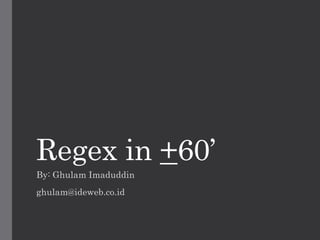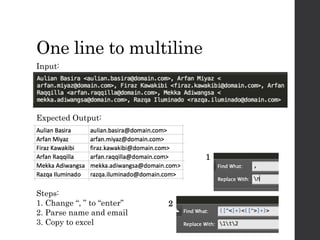Regex intro
- 1. Regex in +60’ By: Ghulam Imaduddin ghulam@ideweb.co.id
- 2. Before We Start • Tools:  Notepad++ (Windows) - https://notepad-plus-plus.org/  Sublime (Mac) - https://www.sublimetext.com/  Online tools - https://regex101.com/ • Sample dataset
- 3. Common Type • Character class: [abc] • Character: . s w d • Quantifiers: ? + * {1} • Anchors: ^ $ • Group/Capture: (…) (a|b)
- 4. Character class • [abc]: single character of: a, b, or c • [^abc]: character except: a, b, or c • [a-z]: character in the range of a-z • [a-zA-Z0-9]: character in the range of a-z or A-Z or 0-9
- 5. Character • . : any single character • s: any whitespace (space, tab); S: any non-whitespace • d: any digit (equal to [0-9]) • w: any word (equal to [a-zA-Z0-9] • t: tab character • r: carriage return • n: new line
- 6. Quantifiers • a?: Zero or one of a • a*: zero or more of a • a+: one or more of a • a{3}: exactly 3 of a • a{3,}: 3 or more of a • a{3,6}: between 3 and 6 of a
- 7. Anchors • ^: Start of string • $: end of string • b: any word boundary • B: any non-word boundary
- 8. Group Capture • (…): capture everything enclosed • (a|b): match either a or b
- 9. Hands-on
- 10. One line to multiline Input: Expected Output: Steps: 1. Change “, ” to “enter” 2. Parse name and email 3. Copy to excel 1 2
- 11. Cleansing & Reformat Input: 1. Step 1 • find: ^(d{1,2})-(d{1,2})-(d{4})$ • Replace with: 3-2-1 2. Step 2: • find: -(d{1})$ • Replace with: -01 3. Step 3: remove non-date line ;) Output: How:
- 12. Q & A



![Common Type
• Character class: [abc]
• Character: . s w d
• Quantifiers: ? + * {1}
• Anchors: ^ $
• Group/Capture: (…) (a|b)](https://image.slidesharecdn.com/regexintro-170630091410/85/Regex-intro-3-320.jpg)
![Character class
• [abc]: single character of: a, b, or c
• [^abc]: character except: a, b, or c
• [a-z]: character in the range of a-z
• [a-zA-Z0-9]: character in the range of a-z or A-Z or 0-9](https://image.slidesharecdn.com/regexintro-170630091410/85/Regex-intro-4-320.jpg)
![Character
• . : any single character
• s: any whitespace (space, tab); S: any non-whitespace
• d: any digit (equal to [0-9])
• w: any word (equal to [a-zA-Z0-9]
• t: tab character
• r: carriage return
• n: new line](https://image.slidesharecdn.com/regexintro-170630091410/85/Regex-intro-5-320.jpg)






